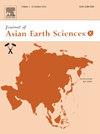Fate of the Late Triassic Songpan-Ganzi Basin in the eastern Paleo-Tethys Ocean: Geochemical and geochronological constraints in the NE Tibetan Plateau
IF 2.3
Q3 GEOSCIENCES, MULTIDISCIPLINARY
引用次数: 0
Abstract
The Songpan-Ganzi Basin in the northeastern Tibetan Plateau preserves well-developed Late Triassic flysch sequences, making it an ideal region for investigating the provenance and tectonic evolution of the basin. This study aimed to constrain the provenance and tectonic setting of the basin by analyzing whole-rock geochemistry and detrital zircon U-Pb ages from Late Triassic flysch sediments. The flysch sequences show low SiO2 (average 51.16 wt%), Al2O3 (average 9.85 wt%) and Fe2O3T + MgO (average 6.56 wt%) values, and K2O/Na2O (average 2.71) ratios, along with high SiO2/Al2O3 ratios (averaging 6.99), suggesting a continental arc setting. They also exhibit moderate chemical weathering (CIA: 60.32–83.72) and high component variability (0.9–2.34, average 1.61), revealing a moderately weathered source. Tectonic discrimination diagrams based on La-Sc-Th and Th-Sc-Zr/10 ratios suggest a continental arc setting. U-Pb ages of detrital zircons mainly range from 222 to 300 Ma and 450 to 520 Ma, reflecting the time of the emplacement of Paleozoic to Late Triassic plutons in the Qinling orogenic belt and Kunlun arc. Minor age peaks (720–850 Ma, 950–1300 Ma and 1400–2400 Ma) suggest subordinate contribution from the northern and western margins of the Yangtze Block. Cumulative proportion curves of zircon U-Pb ages for lower formations exhibit a steep accumulation trend, suggesting a convergent tectonic setting. In contrast, upper formations display a relatively flat accumulation curve, indicative of a collisional environment. This shift in curve characteristics suggests that the sedimentary environment evolved from convergent to collisional settings among the North China, South China, and Qiangtang blocks.
古特提斯洋东部晚三叠世松潘-甘孜盆地的命运:青藏高原东北缘的地球化学和年代学约束
青藏高原东北部松潘-甘孜盆地保存着发育良好的晚三叠世复理石层序,是研究该盆地物源和构造演化的理想区域。通过分析晚三叠世复理石质沉积物的全岩地球化学特征和碎屑锆石U-Pb年龄,对盆地物源和构造背景进行了限定。复理石质层序SiO2(平均51.16 wt%)、Al2O3(平均9.85 wt%)、Fe2O3T + MgO(平均6.56 wt%)、K2O/Na2O(平均2.71 wt%)较低,SiO2/Al2O3比值较高(平均6.99 wt%),显示大陆弧背景。中等化学风化作用(CIA: 60.32 ~ 83.72),组分变异率高(0.9 ~ 2.34,平均1.61),为中等风化物源。基于La-Sc-Th和Th-Sc-Zr/10比值的构造判别图显示大陆弧背景。碎屑锆石的U-Pb年龄主要在222 ~ 300 Ma和450 ~ 520 Ma之间,反映了秦岭造山带和昆仑弧古生代至晚三叠世岩体侵位的时间。较小的年龄峰值(720 ~ 850 Ma、950 ~ 1300 Ma和1400 ~ 2400 Ma)表明扬子地块北缘和西缘的贡献次要。下组锆石U-Pb年龄累积比例曲线呈陡峭的聚集趋势,显示出趋同的构造背景。上部地层的聚集曲线相对平缓,显示出碰撞环境。这种曲线特征的转变表明华北、华南和羌塘地块的沉积环境由会聚环境演变为碰撞环境。
本文章由计算机程序翻译,如有差异,请以英文原文为准。
求助全文
约1分钟内获得全文
求助全文
来源期刊

Journal of Asian Earth Sciences: X
Earth and Planetary Sciences-Earth-Surface Processes
CiteScore
3.40
自引率
0.00%
发文量
53
审稿时长
28 weeks
 求助内容:
求助内容: 应助结果提醒方式:
应助结果提醒方式:


